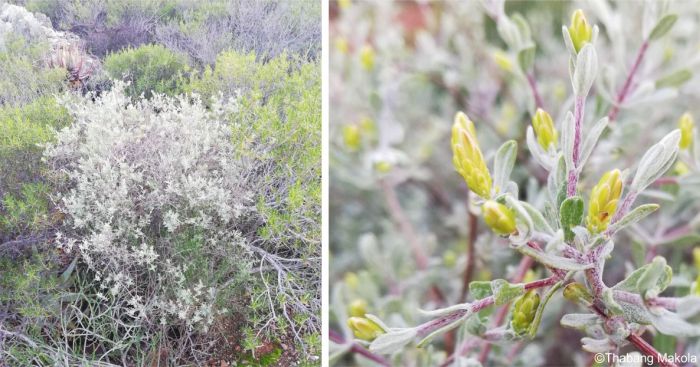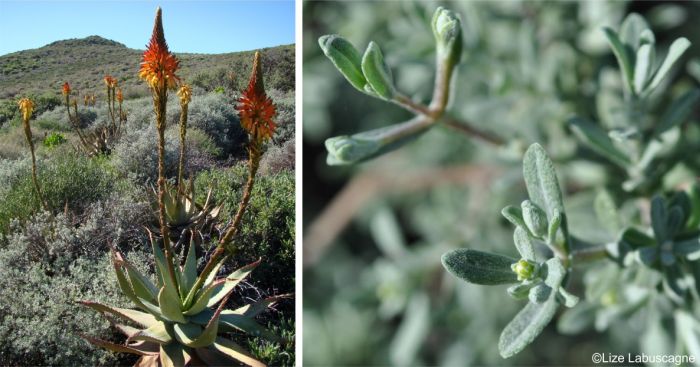Pteronia incana
Pteronia incana (Burm.) DC.
Family: Asteraceae
Common names: ash bush, blue bush, wild lavender bush (Eng.), asbos, asbossie, bloubos, laventelbossie, kraakbos (Afr.).
Introduction
This unpalatable, aromatic, dwarf shrub with beautiful, dusty grey foliage and bright yellow flowers in spring and early summer, is one of the most widely distributed and best known species in the genus Pteronia.

Description
Description
Pteronia incana is a low-growing, dense shrub with an average height that ranges between 0.5 and 1 m. It is often found growing with branches diverging from one another, forming a fine, rounded, mounding shape.
Most often, Pteronia incana has a short, single stem, allowing branches to split in separate directions from the base. However, in some cases the main stem can be obscured or slightly buried underground and it appears to be growing as multi-stemmed shrub. It is comprised of dry, woody, dark-brown stems and branches, which are pubescent when young, turning brown-grey as they get older. About 5 mm long and 3 mm wide, fragrant leaves are light grey in colour, with a white, felt-like material on the surface. Leaves are opposite and have an oblong to obovate shape.
Pteronia incana develops flowerheads that are about 15 mm in diameter, comprised of yellow disc florets, which emit a pleasant coconut scent, in mid-spring to early summer. On average, 10 flowers may be found in a flowerhead. Florets are accompanied by smooth, non-sticky, yellow-green bracts. The fruit is about 5 mm long, a compressed, obovate achene, which is commonly defined as a dry, one-seeded fruit that does not open to release a seed.
Conservation Status
Status
Pteronia incana is not threatened and is thus assessed as Least Concern (LC) in the Red List of South African Plants.
Distribution and habitat
Distribution description
The genus Pteronia is comprised of low-growing, woody shrubs which are sub-endemic to southern Africa. Pteronia incana is native to the Succulent Karoo regions in South Africa and in Namibia. This shrub has a widespread distribution in South Africa, it occurs from the Northern Cape through the Western Cape to the Eastern Cape.
This species is restricted to the arid, winter rainfall region and is the most dominant species in the Little Karoo, also known as asbosveld. Pteronia incana further extends its regions of occurrence to the Robertson Karoo and northwards to the Tanqua, Ceres Karoo and into Namaqualand. It thrives in the Renosterveld vegetation, on lowland flats and small inclines, where soils are often clay-rich and sandy loam, usually derived from shale.

Derivation of name and historical aspects
History
The genus name Pteronia is derived from the Greek word pteron, which means ‘a wing’. However, the reason for the name is not clear. The specific epithet incana means ‘grey’ and is in reference to the appearance of the leaves of this species. The common name asbos, ash bush in English, is also derived from the grey leaves.
The genus Pteronia originates in southern Africa, and is comprised of about 80 species. Within the family Asteraceae, Pteronia is identified as the genus with characteristics that are rare in other related genera. Such characteristics include: spiny habit, opposite and succulent leaves as well as beaked achenes. Most of the species of Pteronia are found in the Karoo-Namib region. However, 12 species have been identified in the Fynbos Biome. Namibia has recorded about 24 species that are native to the country. Some species of Pteronia are found growing in Angola, Lesotho, Swaziland and Zimbabwe.
Pteronia species are usually found dominating in the plant communities that they are associated with. The morphology of Pteronia is diverse and there is significant difference between the species belonging to this genus, in habit, flowers and leaf shapes. Pteronia is considered to be closely related to Engleria and isolated from the African Asteraceae. However, Engleria has radiate capitula, whereas Pteronia has discoid capitula. Pteronia has been placed in the Engleria group, falling under the subtribe Solidagininae of the tribe Astereae. Eventually, Kare Bremer defined the placement of Pteronia in the subtribe Solidagininae as uncertain, because of the pending revision of the entire genus.
Pteronia species were once divided into four sections: Incanae, Papillatae, Ciliatae and Glabratae. It was then noticed that there is no consistence in this division, where significant differences were identified between species in the same section and similarities were also identified in species from different sections. From 144 recorded Pteronia species names, statistics show about 72 accepted species with 50 synonyms and 22 unassessed species. From these species, 2 are recorded as invalid and 1 as illegitimate. Species covered in this series to date are: Pteronia aspera, P. paniculata, P. stricta and P. uncinata.
Ecology
Ecology
Similar to the related species Pteronia paniculata, Pteronia incana cannot resist fire and does not resprout if it is burned in a fire. However, this species abundantly reproduces itself from seeds, which germinate after fires, when conditions are favourable. Related species growing in the Fynbos regions do resprout after fires. Pteronia incana is rarely browsed by the game or livestock and is considered to be unpalatable. Most Pteronia species often secrete sticky resin from the leaves and flower bracts as a defense mechanism to prevent being grazed by livestock. Specific pollinators of this species have not yet been identified, although, the flowers of some species of Pteronia are visited by bees, which may be the pollinators.
Pteronia incana co-occurs with P. pallens and P. paniculata in most of its populations, in dry, rocky habitats with extreme temperatures. The seeds of P. incana are dispersed by wind. It produces single-seeded fruits with a brush-like pappus that helps the seeds with dispersal, making them light and easily carried by the wind.

Uses
Use
For ornamental purposes, ash bush can be added in the designed landscape as a texture plant and for variation in foliage colour as well. This plant is well-suited to landscapes that are designed to be water-wise, or xeriscaped, with its capabilities to tolerate dry conditions for long periods. Not only does this bush offer beautiful, dusty grey foliage to the landscape, it also displays bright, beautiful yellow flowers which can add colour to a dull garden between spring and early summer.
Pteronia incana leaves contain oils that are strongly scented, which are believed to be the reason why it is rarely browsed by livestock. These oils are considered to be volatile, although they have been used commercially as essential oils. Pteronia incana and P. divaricata, are used in traditional medicine to treat influenza, fever, kidney ailments and backache. Other species in the genus Pteronia that are also used traditionally include: P. aspera, which has been identified as an important Nama medicinal plant called inhora or norraboegoe; and P. onobromoides, which was used by the Khoi tribes, who powdered the plant material and mixed it with fats to make a perfumed skin lotion.

Growing Pteronia incana
Grow
Pteronia incana grows well in areas with dry, hot conditions in sandy loam to clay-rich soils with the presence of moderate to coarse sand particles, and a pH of about 5.5.
Pteronia incana is propagated with its relative, P. paniculata, at the Karoo Desert National Botanical Garden, using the same propagation techniques. This species does extremely well when propagated by seed. Seeds are collected in autumn, stored and sown in summer. Use a mixture of sand and sifted potting soil at a ratio of 50:50. Prepare germination trays with good drainage, place coarse bark chips or any coarse particles that will encourage drainage, in the trays. Firmly place seeds on the growth medium and cover them with fine soil particles to avoid being washed away when watering. Ash bush seeds are tiny and should not be buried under the soil when sowing them. Water the seed trays with a fine spray, or mist sprayer, which is preferred for watering tiny seeds. Place trays in a semi-shaded area, keep them moist all the time, and not damp, until germination takes place. Pteronia incana normally germinates in a period of about 2 to 3 weeks, on average.
After germination, reduce watering and allow aeration through the soil. Transplant the seedlings about 3 months after germination. Use sandy loam soil for transplanting, with the addition of organic fertilizers or well-decomposed compost. Do not apply too much of the nutrient supplements to avoid introducing soil-borne diseases to the plants. Handle roots carefully when transplanting and keep seedlings in a semi-shaded area after transplanting, until they are well adapted to their new conditions. When seedlings are well-established, move them to a full sun area before planting into an open space in the garden.
Propagation by cuttings has not being tried on this species at the Karoo Desert NBG. However, one of the relatives, P. aspera is being easily propagated by cuttings at Kirstenbosch National Botanical Garden. Cuttings are done throughout the year. About 30 mm to 60 mm of softwood to semi-hardwood cuttings are made. Make a cutting just underneath the node and dip the cuttings into a rooting hormone that is suitable for semi-hardwood cuttings. Use coarse river sand as a cutting medium, a ratio of 70% river sand and 30% peat or fine potting mix will support the growing of cuttings. Place cuttings in a glasshouse or misting unit with a heated bench. When cuttings have rooted, apply the same procedures as those described above for the transplanting and hardening-off of seedlings.
References
- Döring, M. 2021. Pteronia incana (Burm.) DC. English Wikipedia - Species Pages. Wikimedia Foundation. https://doi.org/10.15468/c3kkgh accessed via GBIF.org on 2021-07-20.
- Foden, W. & Potter, L. 2005. Pteronia incana (Burm.) DC. National Assessment: Red List of South African Plants version 2020.1. Accessed on 2021/07/19
- Hulley, I.M., et al. 2010. The ethnobotany, leaf anatomy, essential oil variation and biological activity of Pteronia incana (Asteraceae). South African Journal of Botany 76, 668-675. doi:10.1016/j.sajb.2010.08.007
- Kakembo, V. 2003. Factors affecting the invasion of Pteronia incana (Blue bush) onto hillslopes in Ngqushwa (formerly Peddie) district, Eastern Cape (Doctoral thesis). Rhodes University, South Africa.
- Latti, I. & Maphisa, T. n.d. Operation Wildflower: Pteronia incana. https://operationwildflower.org.za/index.php/albums/genera-m-z/pteronia/pteronia-incana-thabo-4-3788. Accessed 20 July 2021.
- Makola, T. 2021. Pteronia paniculata Thunb. (Asteraceae). PlantZAfrica. Online. http://pza.sanbi.org/pteronia-paniculata.
- Mayekiso, B., Magwa, M.L. & Coopoosamy, R.M. 2006. Variation in the essential oil constituents of Pteronia incana (Asteraceae). African Journal of Biotechnology 5(12): 1220-1226.
- Oliver, R. 2019. Pteronia aspera Thunb. (Asteraceae). PlantZAfrica. Online. http://pza.sanbi.org/pteronia-aspera
- Vlok, J. & Schutte-Vlok, A.L. 2010. Plants of the Klein Karoo. Umdaus Press, Hatfield.
- Wild Flora Online. 2021. Pteronia incana (Burm.) DC. http://www.worldfloraonline.org/taxon/wfo-0000025449. Accessed on 20 July 2021.
Credits
Thabang Makola
Karoo Desert National Botanical Garden
August 2021
Acknowledgements: the author thanks Lize Labuscagne for the provision of images of Pteronia incana, as credited.
Plant Attributes:
Plant Type: Shrub
SA Distribution: Eastern Cape, Northern Cape, Western Cape
Soil type: Sandy, Loam
Flowering season: Spring, Early Summer
PH: Acid, Neutral
Flower colour: Yellow
Aspect: Full Sun
Gardening skill: Average
Special Features:
Horticultural zones








Rate this article
Article well written and informative
Rate this plant
Is this an interesting plant?
Login to add your Comment
Back to topNot registered yet? Click here to register.